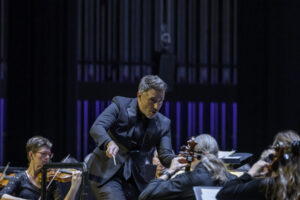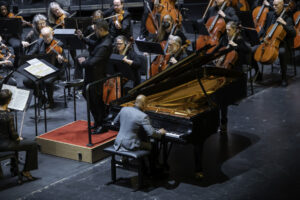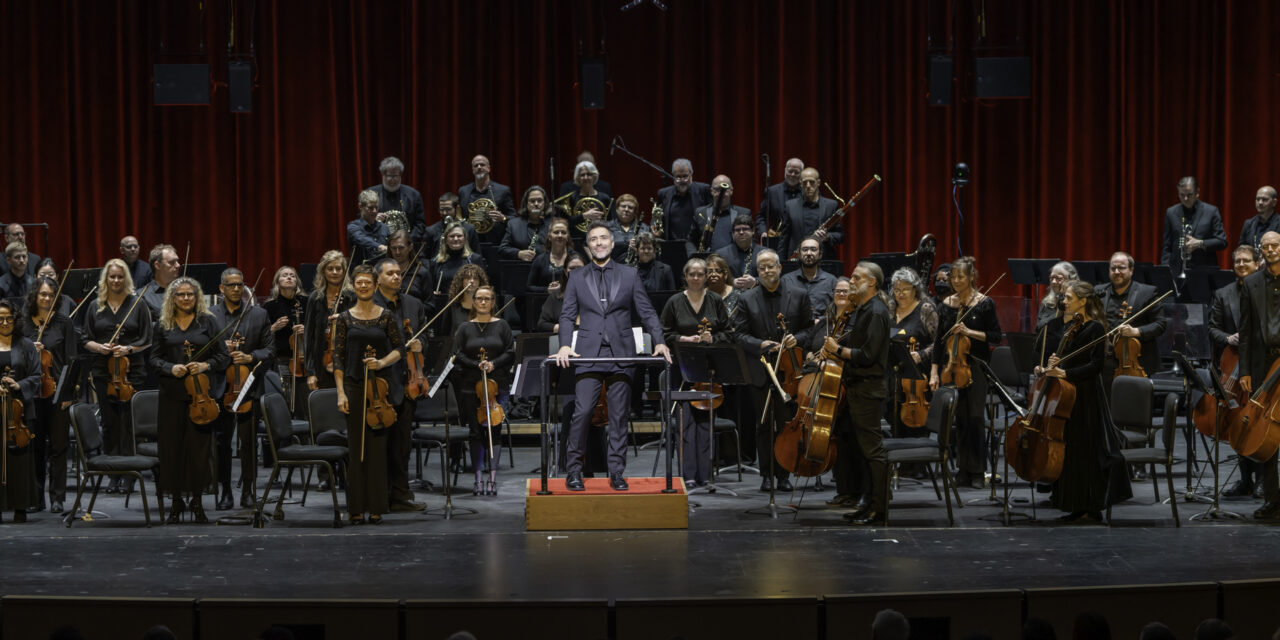 GREENSBORO, NC – Jacomo Bairos, the fourth conductor seeking the Music Director position for the Greensboro Symphony Orchestra, led a concert that was a potpourri of music from the first half of the 20th and 21st centuries. From the last century were works by Sergei Prokofiev (Russia, 1891-1953), Maurice Ravel (France, 1875-1937), and William Grant Still (U.S., 1895-1978); from the 21st is Chris Rogerson (U.S., b. 1988).
GREENSBORO, NC – Jacomo Bairos, the fourth conductor seeking the Music Director position for the Greensboro Symphony Orchestra, led a concert that was a potpourri of music from the first half of the 20th and 21st centuries. From the last century were works by Sergei Prokofiev (Russia, 1891-1953), Maurice Ravel (France, 1875-1937), and William Grant Still (U.S., 1895-1978); from the 21st is Chris Rogerson (U.S., b. 1988).
Maestro Bairos is Artistic Director, Conductor, and Co-Founder (along with composer Sam Hyken) for Nu Deco Ensemble, Miami’s 21st century chamber orchestra (formed in 2015). Formerly he led the Amarillo Symphony, and he is known for his collaboration with contemporary composers and for “challenging the preconceptions of orchestral repertoire.” Incidentally, Bairos added his own personal insights and connections to the already written program notes for the concert.
The short, effervescent Luminosity by Rogerson (written when he was 19 years old) was first up. According to the composer: It “opens with an energetic gesture that is reminiscent of fireworks…the piece relaxes into a middle section that is more lyrical and songlike.” A “heroic and majestic climax of the piece” comes shortly thereafter and “the opening rhythmic drive and energy return to close the work.” Bairos proved to be an athletic conductor, imbuing energy to the orchestra for the somewhat quirky and raucous opener.
Bairos returned to the stage to recognize the composer, who was in the audience. He went on to welcome the audience and to thank the GSO board, the community, and the musicians, whom he described as “world-class.” He also engaged with the crowd, giving a verbal preview of the works that were to follow, starting with excerpts from the 1935 ballet Romeo & Juliet by Prokofiev. The conductor had arranged an eight-movement suite, drawing from two of Prokofiev’s three arrangements of the ballet.
This was a stellar reading that highlighted the composer’s wonderful scene-painting and orchestration skills. The original score calls for a huge orchestra: 14 brass players (including six horns), two harps, a tenor saxophone, two mandolins, three keyboards, and a plethora of percussion (here requiring six musicians). Most of those instruments were present.
From the striking intro to the first movement, depicting the two warring families, the drama was palpable. Bairos took some of the movements at a brisk tempo, which heightened the excitement. But there was also plenty of time for lyrical passages as well. The orchestra’s playing was superb, from barely audible pianissimos to gorgeous solos and thrilling climaxes. Bairos led the ensemble with seemingly endless conducting styles, eliciting the intimate and the boisterous.
 After intermission, pianist Terrence Wilson joined the GSO for Ravel’s Piano Concerto in G (1931). Wilson and Bairos were at Juilliard together and are friends. The pianist is a rising star and has performed both as a recitalist and with orchestras across the United States and Europe.
After intermission, pianist Terrence Wilson joined the GSO for Ravel’s Piano Concerto in G (1931). Wilson and Bairos were at Juilliard together and are friends. The pianist is a rising star and has performed both as a recitalist and with orchestras across the United States and Europe.
Ravel stated that in the three-movement concerto “he was not aiming to be profound but to entertain.” It is, indeed, a delight to hear, but it is also quirky, jazz-influenced, and, especially in the slow, middle movement, beautiful. It calls for plenty of technique – Ravel stated he was “clearly highlighting the soloist’s virtuosity,” which Wilson demonstrated with ease. Fiendishly fast sections, crossing-hands, and passages of perpetual motion were performed as if they were par for the course. Bairos kept a close eye on the pianist making sure orchestra and soloist were perfectly in sync.
Still’s Out of the Silence (1939) was originally the fourth movement from the composer’s Seven Traceries, “a set of mystical piano pieces intended as musical portraits of God.” The work was originally written for Still’s pianist wife, but he later arranged it for orchestra and piano. Wilson served as the sensitive keyboardist for the meditative gem.
Ravel’s Bolero (1928) is one of the most popular pieces in the “classical music” literature. The composer, working with a theme he wrote, stated: “I’m going to try and repeat it a number of times without any development, gradually increasing the orchestra as best I can.” And that is exactly what he did, changing instrumentation along the way, building to the climax at the end.
The piece is anchored by a repetitive rhythm played 169 times; Saturday’s indefatigable snare drum player was principal percussionist, Wiley Arnold Sykes III. The performance obviously thrilled the audience, which leapt to its feet at the conclusion.











